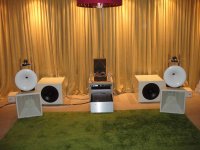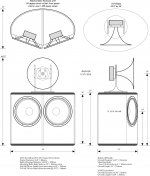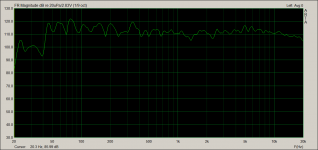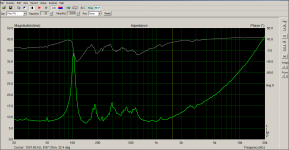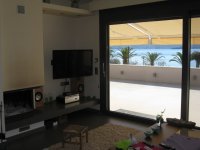The horns are 350hz Tractrix (stated) but they are at F3 by 800hz. I am using the JBL 2441 compression driver with the Radian diaphragm with the mylar surround. The woofer is the JBL E140 15". Not ideal and the bass cabs are designed around the Lambda TD15M which will be going back to AE for reconing. With the tweet off to the side (which I thought would never work well) the sound stage is unbelievable in width and depth. Don't know why it works, but it does. I put foam on the back side of my horns too, but it made no difference with the sound or measurements.
I wish I could lower my horns as the deep male voice is obviously coming from both the woof and the horns. With them closer together, I think there would be more and better integration.
I am using a first order passive but building three amps to go active three way.
Djn,
Very nice system! I never would have thought to use the Heil AMT dipole with a separate tractrix horn. Heil AMT is the best tweeter ever made.
I had pretty good luck with my foam core tractrix hitting 350Hz driven with a TC9FD or a Faital Pro 3FE22. Very sensitive and loud.
http://www.diyaudio.com/forums/full-range/261427-presenting-trynergy-full-range-tractrix-synergy.html
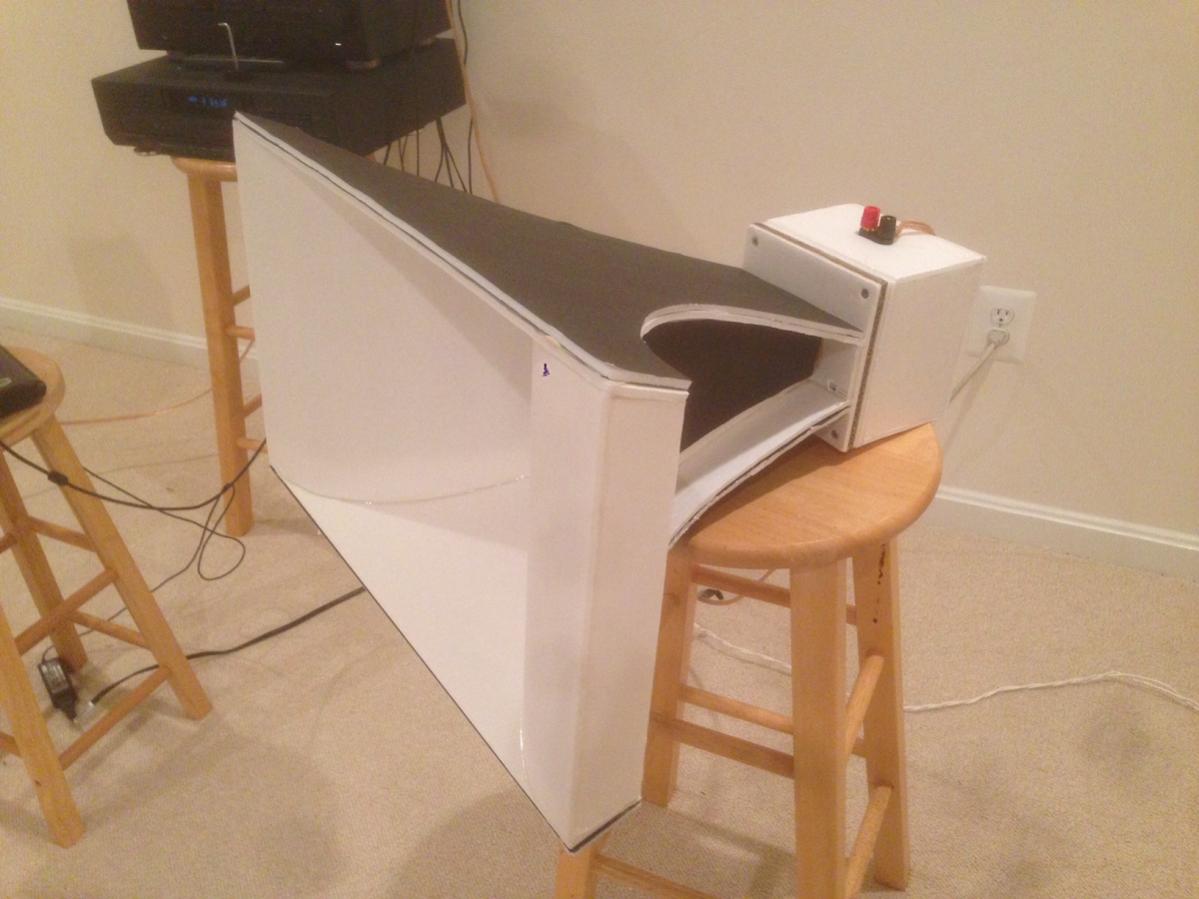
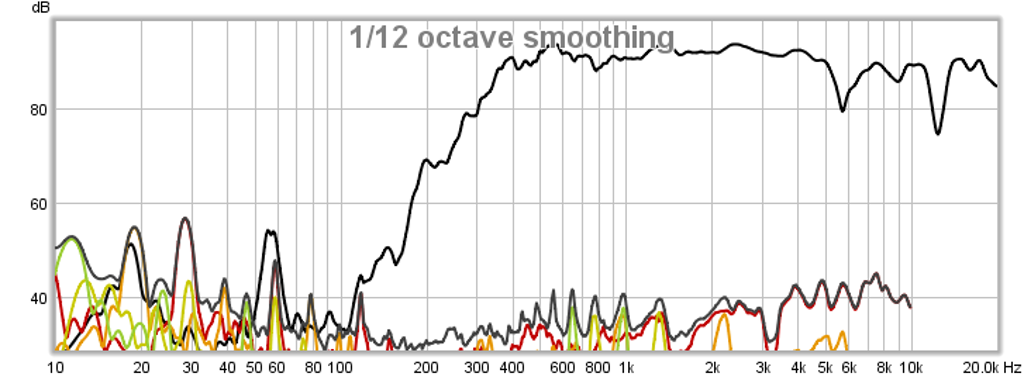
Here it is with a mid and sub integrated:
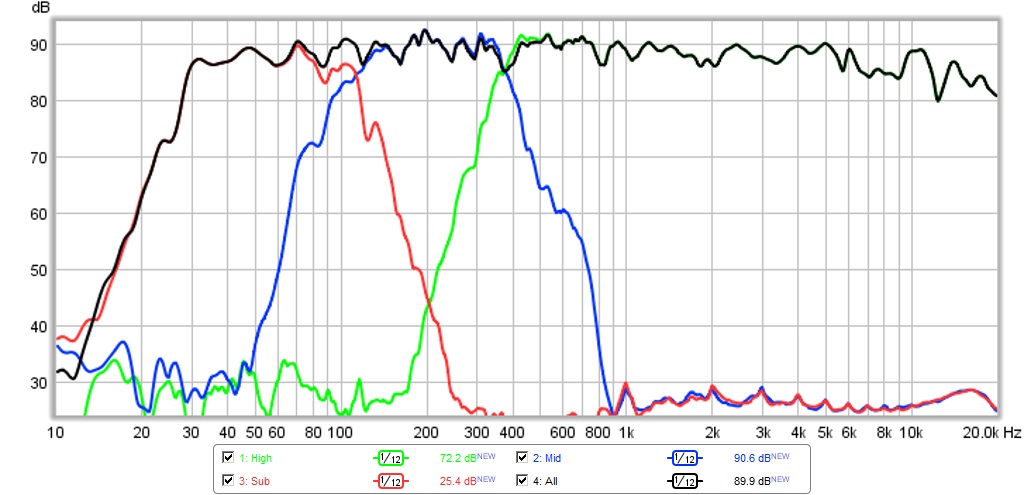
Vgeorge, I've been looking at the Inlow 135 Hz midbass horn as well; very flat and efficient, and a good match to the AH425. The only alternative I can see is a pair of direct-radiators in a closed box, for example, a pair of side-by-side GPA/Altec 416's. Overall floor-space required is similar ... wider for the side-by-side 416's, and deeper for the Inlow 135 Hz midbass horn.
Crossing over to an independently powered (and equalized) subwoofer is a great idea. This relieves the main power amp, and greatly decreases excursion of the mid and upper-bass driver(s). Result, lower IM distortion from the amplifier and the bass drivers, and more headroom for the system.
I'm curious what you discover with different supertweeters, which as you have found, are extremely critical to time-align with the AH425.
Crossing over to an independently powered (and equalized) subwoofer is a great idea. This relieves the main power amp, and greatly decreases excursion of the mid and upper-bass driver(s). Result, lower IM distortion from the amplifier and the bass drivers, and more headroom for the system.
I'm curious what you discover with different supertweeters, which as you have found, are extremely critical to time-align with the AH425.
Attachments
Last edited:
Hi Lynn,
I did consider the 416, but got them shipped to Europe and the cost of import taxes was too much for me. Also preferred the controlled directivity of the midbass horn. Less room reflections and as I have a dedicated music room, floor space is not an issue for me.
I am waiting for a pair of Beyma CP25 to compare with the Fostex 925 I have. I will see what I prefer and keep at the end. Only hope to find the time, as I will be very busy with work until the end of September. With the AH925 you have to time align the super tweeter meticulously, within 1mm or maybe less!
I did consider the 416, but got them shipped to Europe and the cost of import taxes was too much for me. Also preferred the controlled directivity of the midbass horn. Less room reflections and as I have a dedicated music room, floor space is not an issue for me.
I am waiting for a pair of Beyma CP25 to compare with the Fostex 925 I have. I will see what I prefer and keep at the end. Only hope to find the time, as I will be very busy with work until the end of September. With the AH925 you have to time align the super tweeter meticulously, within 1mm or maybe less!
George,
I'm the distant admirer of your system. It's funny and sad at the same time, that at my double teenage age, I find myself drooling over the thing, that I even haven't listened to. And it inspires me to the point, I want to learn everything that requires it to build. Now where should I start... Ah, yes, the math.
I'm the distant admirer of your system. It's funny and sad at the same time, that at my double teenage age, I find myself drooling over the thing, that I even haven't listened to. And it inspires me to the point, I want to learn everything that requires it to build. Now where should I start... Ah, yes, the math.
George,
I'm the distant admirer of your system. It's funny and sad at the same time, that at my double teenage age, I find myself drooling over the thing, that I even haven't listened to. And it inspires me to the point, I want to learn everything that requires it to build. Now where should I start... Ah, yes, the math.
You can start by learning to use ARTA and/or Hornresp with a calibrated mic.
It will be your friend whatever you decide to build!
Vgeorge, if you don't mind, I have two quick questions:
(A) What is the distance from the front of the Inlow 135/B&C8PE21 to the back of the AH425/Altec288?
(B) How much is the AH425/Altec288 attenuated relative to the Inlow 135/B&C8PE21?
I ask because I found the combination of a single direct-radiator closed-box GPA 416, AH425/Radian745Neo, and 3rd-order Bessel crossover had an optimum 416 flange-to-back-of-745 offset of about 11" (280mm), and a required attenuation of about 14 dB. I'm curious where the Island Speakers ended up.
It's obvious your system has much less attenuation for the MF horn, and also has far better directivity control from 135 Hz to 700 Hz ... just curious how what it turned out to be.
Thanks in advance ... and thanks for the inspiration provided by the Island Speakers, it's much appreciated here in Colorado!!!
(A) What is the distance from the front of the Inlow 135/B&C8PE21 to the back of the AH425/Altec288?
(B) How much is the AH425/Altec288 attenuated relative to the Inlow 135/B&C8PE21?
I ask because I found the combination of a single direct-radiator closed-box GPA 416, AH425/Radian745Neo, and 3rd-order Bessel crossover had an optimum 416 flange-to-back-of-745 offset of about 11" (280mm), and a required attenuation of about 14 dB. I'm curious where the Island Speakers ended up.
It's obvious your system has much less attenuation for the MF horn, and also has far better directivity control from 135 Hz to 700 Hz ... just curious how what it turned out to be.
Thanks in advance ... and thanks for the inspiration provided by the Island Speakers, it's much appreciated here in Colorado!!!
Last edited:
Thanks in advance ... and thanks for the inspiration provided by the Island Speakers, it's much appreciated here in Colorado!!!

..and elsewhere as well!
That picture really emphasizes just how compact a good system can be (..even if it is quite deep).
Quite amazing.
The only thing I can recommend is perhaps using some absorption on top of the Inlow horn for the JMLC horn to reduce the reflection (..and maybe raising the JMLC horn up a bit more). You might also be able to enhance depth a bit with an active dipoler super tweeter - perhaps a Heil-type, or the RAAL (..though I'm unsure with the curtain on the front wall).
Last edited:
What surprises me is how advanced this system is compared to what's at the hifi shows. The version I've heard was a rough early prototype (GPA 416 Alnico + AH425/Radian745Neo) with an only partially optimized crossover, and I'd still take that over nearly any system shown at the last RMAF. That's more a comment on the state of the industry than what's possible with high-efficiency, flat-response speakers.
Gary Dahl and Vgeorge have taken things well beyond the early prototype I heard ... more interesting drivers, and better system integration. It's truly international now, with versions in Washington State, Canada, the Caribbean, Australia, and Norway.
One little thing I'd like to suggest is using two supertweeters, one facing forward, and the other facing up and tilted a bit towards the back wall. The forward-facing supertweeter would have the normal crossover as posted at the beginning of this thread, and the additional supertweeter could have a special response shaped to provide a flat room spectral curve.
The issue with the AH425 (or other types of horn such as Tractrix) is the narrowing dispersion at higher frequencies, say from 5 kHz on up. The practical effect is having the overall room energy get "darker" as frequency goes up, with more and more of the sound coming directly from the speaker. By illuminating the ceiling and back wall with an additional supertweeter, the spectral response of the overall room can be restored to a response more akin to a wide-dispersion direct-radiator.
I heard the A/B switchover at the Audio Kinesis room at the last RMAF, and it works really well. If the up/rear tweeter is appropriately shaded from the frontal direction, when you switch it on, there's no degradation of frontal images at all. In fact, the frontal images got a bit more stable and "planted" in location. What changed, though, was the room opened up, and the spatial impression became much more like a real acoustic space, but without the hassle of multichannel playback.
Gary Dahl and Vgeorge have taken things well beyond the early prototype I heard ... more interesting drivers, and better system integration. It's truly international now, with versions in Washington State, Canada, the Caribbean, Australia, and Norway.
One little thing I'd like to suggest is using two supertweeters, one facing forward, and the other facing up and tilted a bit towards the back wall. The forward-facing supertweeter would have the normal crossover as posted at the beginning of this thread, and the additional supertweeter could have a special response shaped to provide a flat room spectral curve.
The issue with the AH425 (or other types of horn such as Tractrix) is the narrowing dispersion at higher frequencies, say from 5 kHz on up. The practical effect is having the overall room energy get "darker" as frequency goes up, with more and more of the sound coming directly from the speaker. By illuminating the ceiling and back wall with an additional supertweeter, the spectral response of the overall room can be restored to a response more akin to a wide-dispersion direct-radiator.
I heard the A/B switchover at the Audio Kinesis room at the last RMAF, and it works really well. If the up/rear tweeter is appropriately shaded from the frontal direction, when you switch it on, there's no degradation of frontal images at all. In fact, the frontal images got a bit more stable and "planted" in location. What changed, though, was the room opened up, and the spatial impression became much more like a real acoustic space, but without the hassle of multichannel playback.
Lynn,
the distance from the front of the 135Hz horn to the back of the 288 driver is 38cm. Low crossed with a second order filter, no zobel. The horn rolls off naturally so there was not much need for attenuation. Just an 3,5 mH coil and a 1uF capacitor.
The AH425 is attenuated 2db.
Just received the second super tweeter that I hope to replace the Fostex one I have, so I hope that I can test what you suggest in the future. Only it has to wait a few months, as I am really busy this time of the year.
Scott,
the front of the mouth of the AH425 is a few centimeters in front of the 135Hz horn, so there is no need for absorption on the mid bass horn. In fact, I tried to locate the AH425 on the further back, and while initially I thought that this placement was marginally better on subjective listening, I had to deal with a lot of reflections from the top of the horn. At the end I decided to place it further front and it was better. Also I plan to place the AH425 a little bit higher and on separate stand so not to touch the mid bass horn. But that has to wait for winter! Along with super tweeter trials.
I attach some of my initial measurements, an impedance measurement of the 135Hz horn (maybe of use to Lynn) and an frequency response of all the system, both speakers at listening position, with no special measures. I was looking only for the crossover at this time. Kindly note that now it measures even better, as I have adjusted the woofers a little bit better and the small dip in the 1,3kHz was due to mic placement probably, but these were the last measurements that I had saved.
the distance from the front of the 135Hz horn to the back of the 288 driver is 38cm. Low crossed with a second order filter, no zobel. The horn rolls off naturally so there was not much need for attenuation. Just an 3,5 mH coil and a 1uF capacitor.
The AH425 is attenuated 2db.
Just received the second super tweeter that I hope to replace the Fostex one I have, so I hope that I can test what you suggest in the future. Only it has to wait a few months, as I am really busy this time of the year.
Scott,
the front of the mouth of the AH425 is a few centimeters in front of the 135Hz horn, so there is no need for absorption on the mid bass horn. In fact, I tried to locate the AH425 on the further back, and while initially I thought that this placement was marginally better on subjective listening, I had to deal with a lot of reflections from the top of the horn. At the end I decided to place it further front and it was better. Also I plan to place the AH425 a little bit higher and on separate stand so not to touch the mid bass horn. But that has to wait for winter! Along with super tweeter trials.
I attach some of my initial measurements, an impedance measurement of the 135Hz horn (maybe of use to Lynn) and an frequency response of all the system, both speakers at listening position, with no special measures. I was looking only for the crossover at this time. Kindly note that now it measures even better, as I have adjusted the woofers a little bit better and the small dip in the 1,3kHz was due to mic placement probably, but these were the last measurements that I had saved.
Attachments
Last edited:
Scott,
the front of the mouth of the AH425 is a few centimeters in front of the 135Hz horn, so there is no need for absorption on the mid bass horn. In fact, I tried to locate the AH425 on the further back, and while initially I thought that this placement was marginally better on subjective listening, I had to deal with a lot of reflections from the top of the horn. At the end I decided to place it further front and it was better. Also I plan to place the AH425 a little bit higher and on separate stand so not to touch the mid bass horn. But that has to wait for winter! Along with super tweeter trials.
I attach some of my initial measurements, an impedance measurement of the 135Hz horn (maybe of use to Lynn) and an frequency response of all the system, both speakers at listening position, with no special measures. I was looking only for the crossover at this time. Kindly note that now it measures even better, as I have adjusted the woofers a little bit better and the small dip in the 1,3kHz was due to mic placement probably, but these were the last measurements that I had saved.
Pretty good measurements, but the horn's a bit resonant.. maybe some 6"+ thick acoustic insulation as a frame around the mouth, and perhaps some green-glued weight on each outer "panels" of the horn? Done well that should knock-down the ripple.
..and yes, definitely try it again with further set-back, top-panel absorption, and up higher on its own frame.
-at winter of course.

Note: a thick blanket(s) wrap and some measuring should tell you if you'll gain anything by most of these potential mod.s without costing any money. (..maybe some sand in a large bag for at least 3 of the 4 panels to try the panel damping.. ..err, you do have a beach with sand on that island of yours, right?)
Last edited:
All these are good suggestions, thanks. Will have something to do in winter!
FYI, it was also suggested by Martin Seldon to use some sort of bitumen on the back of the horn.
When I have the separate stand it will be easier to experiment back and forth.
But put absorption on the top of the mid bass is not so nice aesthetically. I did experiment with that and did not look good a all.
I have a beach just in front of my door, so sand is not a problem
FYI, it was also suggested by Martin Seldon to use some sort of bitumen on the back of the horn.
When I have the separate stand it will be easier to experiment back and forth.
But put absorption on the top of the mid bass is not so nice aesthetically. I did experiment with that and did not look good a all.
I have a beach just in front of my door, so sand is not a problem
I have a beach just in front of my door, so sand is not a problem
Mmm, that bumps the real estate price up at least x5.
(..seems Greece is having a bit of a money problem and is taking it out on their citizens with escalating property taxes.)

Note: you can craft a "solid" frame (like the frame of a painting) around the mouth of the horn and then wrap that frame (just the acoustic "paneling") in the cloth of your choice and have a very good looking design. ..something you can try in perhaps sketchup. Depending on the frame's depth, you likely won't need anything additional on the "top" of the horn for absorption for the upper horn.
Also, do NOT use bitumen to damp the side panels.. think of the VOC's that will pump into your room and lungs. It also doesn't do a very good job in most cases. You just need a heavy plate (metal, ceramic, etc..) with a very thin layer of green-glue - creating a mass damper.
please don't tell us that you have sea views behind those curtains (if so we will need a picture with the curtains open)
No, this is in the basement. Family has the seaview on top. The good thing is that the room is fairly isolated from outside noises and wife kids etc!
I can listen to music when other watch TV, cooking and doing their things.
Have a glimpse pf my TV system with some of the view. Speakers are using Jordan units.
Attachments
Have a glimpse pf my TV system with some of the view.
Ok, I think that sparked more envy for me than the sound system!
Lynn, the distance from the front of the 135Hz horn to the back of the 288 driver is 38cm. Low crossed with a second order filter, no zobel. The horn rolls off naturally so there was not much need for attenuation. Just an 3,5 mH coil and a 1uF capacitor.
The AH425 is attenuated 2db.
To a first approximation, it looks like the acoustical center of the Altec 288 is 1~1.5 wavelengths in front of the acoustical center of the B&C 8PE21 (at 700 Hz, and allowing for the additional delay of the electrical lowpass filter). This is easily accounted for in the crossover, and the audibility of the group-delay variation is a matter of conjecture. Potential reflections off the top of the Inlow 135 Hz basshorn are probably more audible than the GD variation.
What is significant is the overall system efficiency of 107 dB/meter (if the Altec 288 is 109 dB/meter as claimed). 107 dB/meter is in Klipschorn/LaScala territory, with much flatter response, and not as much FR ripples and group-delay variation as folded horns usually have.
There's also extension of directivity control down to 135 Hz. I'd expect a reduction in room modes in the 135 to 300 Hz region, as well as side-stepping problems from internal standing waves in large bass enclosures. Both are probably significant and audible as crispness and clarity in the "power" region of the spectrum. I imagine it sounds dramatically better than the previous version ... congratulations on an outstanding result!
P.S. The other similarity to the Klipschorn/LaScala is the 5 kHz transition to the supertweeter, and this is where Volti Audio's tweeter comparisons make for interesting reading. The humble Beyma CP25 comes out pretty well.
Last edited:
P.S. The other similarity to the Klipschorn/LaScala is the 5 kHz transition to the supertweeter, and this is where Volti Audio's tweeter comparisons make for interesting reading. The humble Beyma CP25 comes out pretty well.
Dear Mr. Olson,
I have a nagging doubt regarding supertweeters myself, and I would be grateful if you could share your opinion on this with me.
The issue is that at such high crossover frequencies (say, ~7kHz), assuming the two drivers' emissions to be in phase at all frequencies and adopting a crossover topology designed to produce a 0dB sum when both are at -6dB seems like wishful thinking, since in reality the relative phase of the two drivers' outputs will vary considerably over even a narrow listening/measurement angle.
As a result, even very small changes in the listening/measurement position produce visible alterations in the summed frequency response of the (horn-loaded) "mid" + supertweeter, thereby defeating any attempt to carefully "time align" the two drivers. In fact, I found that if one were to insist in adopting such a crossover topology, the result would often be a deep notch in the summed response when listening even slightly off axis.
One possible way to sidestep the issue is to instead adopt a "constant power" crossover, which just assumes the two drivers' outputs to be non-correlated, and hence produce a 0dB sum when both are at -3dB, and at the same time intentionally mis-align the supertweeter rather crudely (i.e. by bringing it towards the front of the horn, rather than pushing it back to line up with the compression driver's diaphragm). The relative phase difference between the "mid" and the supertweeter's emissions will thus vary by > 360 degrees over the approx. two octaves of overlap (e.g. assuming a 2nd order Butterworth crossover), making them effectively non-correlated from a practical standpoint.
While this obviously results in a clearly visible "comb filter" pattern, the latter should arguably not be audible, since the notches fall within the "ERB" (Critical band - Wikipedia, the free encyclopedia), and the smoothed summed response is approximately flat, and remains so both on-axis and off-axis.
Operating this way, though, the impulse response will exhibit a clear double peak (first, the one by the supertweeter, and then the separate one by the "mid"). While the human hearing system is insensitive to phase variations per se at frequencies > 5kHz (the "phase locking" mechanism of the auditory cells becomes ineffective), there does appear to be some evidence that we are still able to detect even very small differences in the arrival times of separate impulses...
So, my question for you is, which do you see as the lesser necessary evil, as it were:
(1) the (often gross) off-axis frequency response aberrations caused by out-of-phase cancellations resulting from a "time-aligned" All-Pass Crossover, or
(2) the double impulse response caused by an intentionally mis-aligned Constant-Power Crossover?
My sincere thanks,
Marco
Hi, Marco!
Both types of crossover will produce nulls off-axis, just in different locations. This is true regardless of the phase angles between the two drivers ... there's always a spatial location where the drivers are acoustically out of phase with each other.
The trick with a supertweeter is selecting a frequency where narrowband nulls, or more broadly, comb filtering have low audibility. In my experience, this is true for 7 kHz or higher. Nulls or comb filtering can result in unexpected elevation effects, thanks to mimicking pinna filtering, but there's not much effect on tone.
5 kHz? True, the vertical separation between drivers is several wavelengths, which is a no-no at lower frequencies, but I've found the biggest discontinuity is between drivers of different classes. If the overall tonality and dynamics are similar, integration is less difficult.
I still aim for a single impulse response at the listening position, though, even if it's a little funky off-axis. Dips in response, particularly for frequencies of 5 kHz and above, are much less audible than peaks, which have a way of standing out and drawing your attention to the crossover.
Both types of crossover will produce nulls off-axis, just in different locations. This is true regardless of the phase angles between the two drivers ... there's always a spatial location where the drivers are acoustically out of phase with each other.
The trick with a supertweeter is selecting a frequency where narrowband nulls, or more broadly, comb filtering have low audibility. In my experience, this is true for 7 kHz or higher. Nulls or comb filtering can result in unexpected elevation effects, thanks to mimicking pinna filtering, but there's not much effect on tone.
5 kHz? True, the vertical separation between drivers is several wavelengths, which is a no-no at lower frequencies, but I've found the biggest discontinuity is between drivers of different classes. If the overall tonality and dynamics are similar, integration is less difficult.
I still aim for a single impulse response at the listening position, though, even if it's a little funky off-axis. Dips in response, particularly for frequencies of 5 kHz and above, are much less audible than peaks, which have a way of standing out and drawing your attention to the crossover.
Last edited:
- Status
- This old topic is closed. If you want to reopen this topic, contact a moderator using the "Report Post" button.
- Home
- Loudspeakers
- Multi-Way
- My island speakers
